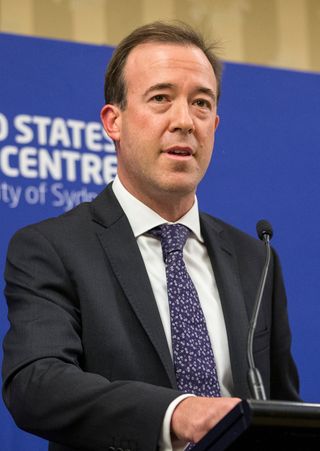Australian historian Neville Meaney once compared the post-war trajectories of Japan and Australia, concluding that each had been on a path towards becoming “normal” nations.
Where Japan embarked on massive reindustrialisation following defeat in World War II, balancing a commitment to the West with its Asian setting, so Australia had to find new ways of connecting to the region as British patriotism and its untenable thread of racism collapsed.
Since their 1957 Commerce Agreement, Australia and Japan have become more deeply involved to a degree unthinkable in earlier times.
While from the 1970s much of the enthusiasm for closer ties stemmed from a relationship founded on economic complementarity, China’s rise has been changing that dynamic for some time.
Even if some in Washington still see Tokyo and Canberra as the northern and southern anchors of the US Asian alliance system, both have for some time looked beyond those moorings even as they encourage the US to rediscover regional resolve.
Indeed the Reciprocal Access Agreement agreed to last week by Prime Minister Scott Morrison and his counterpart Yoshihide Suga in Tokyo can be seen as big step, if not the culmination, of this recent shared strategic vision. That vision began in earnest towards the end of Paul Keating’s term in office and was further enhanced under the Howard, and later Abbott and Turnbull governments.
As former ambassador John McCarthy argued in these pages last week, the RAA underlines a trend in recent years where the two countries see each other as security partners in their “own right rather than as joined by security connections in common with the United States”.
Even if some in Washington still see Tokyo and Canberra as the northern and southern anchors of the US Asian alliance system, both have for some time looked beyond those moorings even as they encourage the US to rediscover regional resolve.
As the first foreign leader to visit Prime Minister Suga, Morrison wanted to ensure both countries maintain momentum in the security relationship. Undoubtedly, too, he looked to understand how Suga might handle the long-running difficulties his predecessor, Shinzo Abe, encountered in making critical adjustments to Japan’s pacifist constitution that would make Japanese deployment of its armed forces in support of allies both possible and more easily sold to the Japanese electorate.
There was no doubt also discussion on how each was handling China, including respective responses to Chinese coercion. The visit underlines the belief that no one country in the region can balance China by itself.
But what remains a question is whether or not, in common with earlier times, the Australian side might be reading a little more into the agreement than its counterparts.
Cautious Japanese response
Morrison and others have to some extent hyped the announcement. Journalists here have characterised the RAA in grander terms as a “pact”, when it is clearly akin to a Status of Forces Agreement (SOFA): one that has been exhaustively negotiated for six years and focused on the freer movement of respective militaries and materiel between the two countries as well as supporting “joint involvement in broader multilateral exercises”.
It is probable the more cautious Japanese response is calculated to smooth its passage through the Diet and differentiate it from longstanding tensions arising from the stationing of US troops on Okinawa.
Morrison later inflated the agreement as a “landmark defence treaty”, adding that “the only other such agreement that Japan has struck with another country is with the United States 60 years ago”.
Such an agreement could also open the door to the Japanese Self-Defence Forces concluding similar arrangements with other countries.
Morrison later inflated the agreement as a “landmark defence treaty”, adding that “the only other such agreement that Japan has struck with another country is with the United States 60 years ago”. But let’s be clear: it is not an alliance with mutual security assurances.
So it’s quite different from the 1960 US-Japan treaty of mutual co-operation and security that provided Japan with a nuclear umbrella and tied Japan tightly into the US’ military posture in Asia. The US also signed a SOFA with Japan that year: it’s this agreement to which Morrison was probably referring.
The two leaders also released a strong joint statement in which they committed to remain “in close communication” on the East China Sea, where China and Japan dispute ownership of the Senkaku/Diayu islands.
That has touched Chinese sensitivities. Certainly there will be some in Beijing who believe all this has come at the urging of Washington.
The Prime Minister’s words about this agreement not being directed at any one country – and that neither Japan nor Australia is in “strategic competition” with China – are harder to square away. The joint statement suggests otherwise. China was not as much of a concern six years ago. It is now.
As former Australian ambassador to Japan Bruce Miller remarks, “we started negotiating the agreement because we wanted to facilitate our practical on-the-ground defence co-operation, such as humanitarian assistance and disaster relief, but we concluded negotiations at a time when China’s activities are far more of a concern, so inevitably the agreement conveys a firm signal about our growing strategic alignment”.
Morrison called this a “very special relationship” – a new level of intimacy for bilateral ties whose military content only deepens. And the RAA has been readily woven into Canberra’s broader security narrative; a strong signal, too, to US president-elect Biden.
Tempting as it may be to see this agreement, along with a strengthening India/Japan relationship and a revitalised Quad, as cleverly symmetrical, the fluidity of the strategic environment, along with the persistence of distinctive national interests, rarely allows for such neat packaging.
Make no mistake. This agreement is a big deal for Australian foreign policy, but it’s not the “pact” or alliance that some commentary has dressed it up to be.






